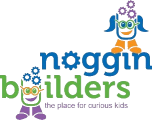We’ve all seen it happen: A child in our care is stumped by a challenge.
A 3-year-old’s tower of blocks keeps falling over and she can’t figure out why. A first grader is trying to mix paints to get green and keeps making brown. A 12-year-old routinely forgets to bring his lunch to school.
What do we adults do? Do we rebuild the tower, show the first grader that it’s blue plus yellow? Bring the lunch to school ourselves?
It’s easy—and natural—to want to step in and help. But then, guess what? We’re not really helping. Kids need to learn, in age-appropriate ways, how to solve their own problems.
Developing kids’ ability to think creatively and strategically means they’ll be able to find solutions themselves—that’s our mission at Noggin Builders. Your child may or may not grow up to become an engineer. But eventually, they’ll need to navigate larger challenges on their own, like juggling a heavy college course load, traveling alone, or dealing with a difficult co-worker.
They can succeed if they know the basic steps to approaching a problem: assess the situation, brainstorm and evaluate options, pick a solution to try, and then test that idea.
Adults should be coaches, not players
If you’re the forgetful 12-year-old’s parent, what could you do instead of turning into a lunch delivery service? First, ask your child to consider why he keeps forgetting his lunch. Where’s the breakdown? Then, what solutions can he think of (maybe setting an alarm on his phone or putting a Post-It note on the door)? Have him try different techniques to see what works best for him.
In the case of the first-grader mixing paints, you can help frame the situation. “So you tried blue and red, and you tried red and yellow. What else can you try mixing?”
For more suggestions, see Tips for parents, below.
Dr. Robert Brooks, an expert on children and resilience from Harvard Medical School, says it’s never too early to start this process. “When there’s a problem, a parent can say to a child, ‘Can you think of one or two ways to solve it?’ So the message is constantly, ‘You have the resources to come up with solutions yourself.’”
Hands-on learning through STEM
Again, problem-solving isn’t just for scientists. But STEM “problems” provide a great means of teaching these strategies. Here are a few examples of challenges kids might tackle in Noggin Builders classes:
- Create a “bear cave” using classroom furniture. Now, how can you get all the classroom “bears” into the cave?
- Build a device out of popsicle sticks, plastic syringes and tape that uses pneumatics to lift an object.
- Explore ways to create a chemical reaction using yeast. Figure out how varying the amounts of substances used will affect the result.
- Build a stomp-rocket launcher using PVC pipe and create paper rockets, testing different designs.
- Design, build and code a robot to sort and stack cubes based on color.
In our workshops, children can learn basic physics and chemistry while they’re designing structures or experimenting in the kitchen. Older kids might even learn coding, then apply that knowledge to get machines to do tasks (also known as robotics). But mostly, they’re learning how to find solutions to any challenge.
Tips for parents
Are you encouraging your kids to problem-solve at home? Here are a few simple ways to do so:
- Get into the habit of asking kids for their own ideas when problems arise. Why do you think you’re so tired in the morning? What are some things you can do when you feel left out at lunch? How could you keep the dog from chewing on your things?
- Let them entertain themselves. People, especially children, need empty time and space to let their minds wander (yes, this means away from electronics). It’s okay if they say they’re bored at first. Offer the backyard or some craft materials and let them use their imaginations.
- Play games together. Strategy games like Monopoly, Battleship, Mastermind and chess (check out these ideas for younger kids) can help build skills that transfer to other areas of life.
- Allow kids to experience failure. Natural consequences are a great teacher, and learning to deal with and learn from mistakes is a critical part of growing up. When kids can see “failure” as just one part of an experiment, they’ll be better equipped to take on the world.

